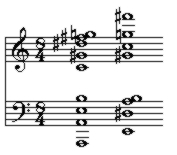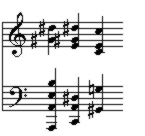General Principles of Harmony – Harmony, Texture and Orchestration
One unsettling aspect of most books on harmony is that, in reducing harmonic textures for analytical purposes, they dilute or remove some of the most salient harmonic effects: the way the notes are disposed in musical space (register), and the composer’s choices of doubling and timbre. Any pedagogical or analytical regime that does not concentrate on what is most audible – these dimensions of sound are not minor details – is bound to remain musically feeble.
SPACING AND REGISTER
The overtone series is a rough guide to harmonic clarity. Generally, the more a chord is spaced with wider intervals on the bottom, and smaller intervals above, the more it will favor blended resonance. Clear acoustic intervals (e.g. octaves and fifths) on the bottom tend to ground the harmony, regardless of what is above.

These second chord here is an “inversion” of the first. (This example once again shows how the concept of “inversion” in chords with many different chromatic notes is meaningless.) Note the enormous difference in effect between the two chords. The first chord sounds like a colorful elaboration of an A minor harmony, due to the octave A in the bass and the supportive fifth above it. The second chord sounds rootless; the only acoustically strong interval is the 5th C-G, hidden in the middle parts.
Of course, a composer may legitimately want expressive effects like dark, close chords in the bass, to suggest confusion or heaviness of spirit. But they should not result inadvertently.
Another point: As we have seen previously, harmonic tension is softened by registral separation, since the ear is less inclined to associate widely spaced dissonant notes with each other. At their most extreme, such gaps create separate planes of tone.
Note that register is directly related to clarity and character. Pitch clarity is always greatest in the middle register, where human hearing has evolved to make the most precise distinctions. (In teaching composition, it is often useful to suggest to students that they try harmonic effects in various registers, before settling on the “default” middle range.)
DOUBLING
Apart from spacing and register, choice of doubling is also important. One problem with classical serial writing is its rigid avoidance of octave doubling. Not only does this make clarity in the extreme registers of the orchestra almost impossible, but it also closes off interesting harmonic effects, which use doublings to color a chord in particular ways. Although octave doublings do indeed change the flavor of the harmony, that is no reason always to avoid them; a better goal is to use them in ways that are intentional and expressive.
Doublings are not all equivalent in effect. Doubling will emphasizethe role of the note which appears more than once. Doublings of bass notes add more solidity than doublings of middle notes, and adjacent doublings (unseparated by other notes) are more noticeable than non-adjacent ones.

Note the effects of different doublings in these three chords. In the first chord, doubling the A on the bottom gives it the feeling of a root, as does the fifth above it. In the second chord, doubling the D#, in semitone conflict with the E, creates more tension, and a heavier sound. In the third chord, doubling the C, consonant with both G# and E, gives the chord a richer sound.
Finally, it is worth mentioning that organ registration, with its use of doublings at pitches other than the octave (mutation stops) to create distinct, new timbres, can provide interesting harmonic effects. The classic example of this technique can be found in Ravel’s Bolero.
TIMBRE
Another element often ignored in traditional harmony study is the difference between instrumental and vocal writing. Suspensions written for the piano are very different when played by the organ; attacked dissonances, difficult for voices, are easier for strings.
In fact, timbre affects the sound of any interval. Clusters are quite aggressive on the organ, but soften enormously when played by strings (possibly because slight, continuous fluctuations of pitch in the latter provide inner mobility). Octaves and fifths in brass instruments have a richness and fullness unequaled by the same intervals played by woodwinds. Low, closely spaced chords in trombones have a richness which is very different from their (relative) heaviness when played by horns. In short, beyond the most elementary work, harmony cannot and should not be separated from orchestration.
HARMONY WITH MULTIPLE PLANES OF TONE
A chord is normally perceived as a unit. However, it can also include subgroups (“planes”), particularly if the orchestration encourages such “streaming”, through registral and/or timbral separation.

In “A”, when the homogenous strings here play the chord, the two highest notes blend with the overall mass. The same chord, orchestrated as in “B” , presents two distinct timbral layers: a background string chord, and a foreground dissonance in the trumpets. Our hearing of the harmony now focuses more acutely on the dissonance G-Ab, leading to different expectations about the music to follow.
The point here is that virtually all harmony texts assume complete and continuous unity of tone. In real life, however, there is a world of expressive potential to be explored in multi-layered harmonic textures, and in various degrees of blend between planes of tone. Further, such stratification is a powerful means of exploring harmonic complexity without creating heaviness and inertia. This is especially true if the various layers are distinguished by distinct interval characters, timbral and/or registral separation, and rhythmic independence.
